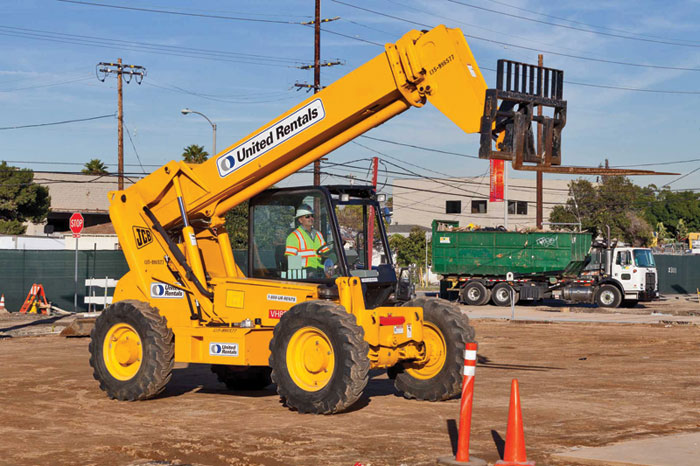The 2013 Rental Outlook
The construction market is slowly growing. The economy is steadily rebuilding and deleveraging debt, and the contractors, owners, municipalities, manufacturers and distributors in the construction industry are experiencing a slow and frayed recovery. But the uneven recovery has meant that some construction markets have recovered faster than others, and that is going to be the case for the foreseeable future. One such industry has been rental.
“The secular shift toward equipment rental is one of the leading trends in our end markets,” explains Matt Flannery of United Rentals Inc., which claims the world’s largest fleet of rental equipment. “It has long-term implications for almost every area of the construction business: operating efficiency, worker safety, productivity, use of capital and entry into new types of project work. For many contractors in the United States, the past several years have been a perfect storm of challenges. In addition to tighter access to capital, commercial construction went through a substantial decline. The economic benefits of renting, and the flexibility it offers in terms of bidding on different types of work, have helped to drive rental penetration.”
The American Rental Association (or ARA) continues to track the equipment rental industry via IHS Global Insight data as reported through the ARA Rental Market Monitor. After experiencing a growth rate of 8.8 percent in 2012, according to said monitor, the equipment rental industry is expecting 2013 to be another year where the rental industry outpaces GDP by four times (GDP will likely remain between 2 and 2.5 percent for the next several years). The continued significant growth can be attributed to several factors.
“Construction professionals see the value of renting which gives them the right equipment, at the right time to maximize efficiency, reduce overall costs and increase profitability,” explains Christine Wehrman, executive vice president and CEO of ARA. “Credit markets also remain tight and there’s an uncertainty in the economic recovery, which has led to a higher level of growth in the equipment rental industry.”
According to ARA’s forecast, industry revenue will grow another 7.6 percent in 2013 to reach $33.5 billion. What does that mean for contractors? Well for starters, overall rental rates have gone up by approximately 7 percent, according to Flannery. That means renting is getting more expensive for contractors. But rental houses say contractors are getting more bang for their buck. National chains like United Rentals are now offering technologies like Total Control (added once the company merged with RSC). The software helps large customers manage equipment consumption and realize savings, which in turn cements their relationship with renting.
“At our most recent Investor Day, we cited a case where Total Control was able to save a global drilling company $1.8 million in equipment costs in just one quarter, which subsequently secured an estimated $12 million of new business from that customer annually,” says Flannery.
Increasing the level of customer service and quality of rental has been and will continue to be a primary focus of successful rental chains — folks like Volvo Rents.
“Investment in new rental and service fleet that reduce downtime and completes work more efficiently has been a major focus for Volvo Rents,” explains Matt Tavianini, vice president of sales and marketing at Volvo Rents. “Volvo Construction equipment has historically been a leader in fuel efficiency. In some cases vs. customer aged fleets, we have been able to offset the cost of the rental with fuel savings alone.”
The rental industry overall has done an excellent job of convincing contractors to think through all the various costs of owning equipment before making a capital purchase. It’s fairly easy to calculate the cost of capital, but for a true analysis, you have to also think about insurance, documentation, maintenance, parts, shop space, disposal costs and overall hassle. For many contractors, the economic benefits of renting, and the flexibility it offers in terms of bidding on different types of work, have been a real eye-opener during the downturn. Those same contractors are now seeing the rental option as a sound business strategy in the recovery, which is why growth in the equipment rental industry has been outpacing the recovery in construction.
There are of course challenges. Economic uncertainty is the most significant issue. ARA’s Government Affairs Division and Political Action Committee (ARAPAC) work on key issues that affect members — taxes, healthcare, transportation/infrastructure and energy are key areas of significant importance in 2013.
“We believe the biggest threat to the equipment rental industry is the same as for all other businesses in America,” says Wehrman. “We have a fragile economy that is facing substantial uncertainty because the policy process has been unable to resolve this uncertainty.”
Also, the entry of more expensive Tier 4-compliant diesel engines into the rental industry has had mixed effects. Because rental companies replace equipment with greater frequency than other equipment owners, these businesses will often have the latest Tier 4 equipment in their fleets. There is (of course) an additional cost involved for rental fleets when purchasing equipment with Tier 4 engines, so that cost (of course) will be passed along to the renter to some degree. Luckily, many rental houses are cognizant of adding too much extra cost and are only supplying Tier 4-compliant equipment when it’s required.
“For some product lines, such as power generation, the additional cost is substantial, and we have no option but to charge more for that fleet looking forward,” says Flannery. “But we did buy some additional Tier 3 equipment early in 2012, after confirming that it would not affect our compliance or our customers’ compliance in areas that have stricter emissions standards. We continue to review our options as well as our customers’ needs.”
Over the next 10 pages, we also continue to discuss the many customer options in the rental industry. We have detailed eight different compact machines and all the major options for contractors eyeing those particular rental categories. We foresee 2013 as a slow growth year for most of the construction industry, based on a continuation of the moderate increase in demand in non-residential construction that we saw in the back half of 2012 (most likely in the mid-single-digits year-over-year). Commercial construction will continue to be the lagging sector, but overall the landscape will improve (especially housing and multifamily housing). This ties into what we’re hearing from our readers, as well as industry analysts. Considering all that, what about a little rental advice for the customer?
“Plan in advance with your rental partner,” says Tavianini. “It’s a daunting task to say the least, but knowing where you are in the rental cycle and potential equipment shortages will make the process more efficient and more fiscally sound. The invoice cost is only a percentage of the total cost. If your operation is spending additional time to search for the right equipment, research and clear invoice discrepancies, you are spending additional dollars on rental that you don’t necessarily see on a profit and loss statement. Work with your rental vendor early in the year to establish best practices. When the workflow increases, you will not have to go through a discovery practice of your rental process and needs.”
Keith Gribbins is managing editor of Compact Equipment, based in Brecksville, Ohio.





